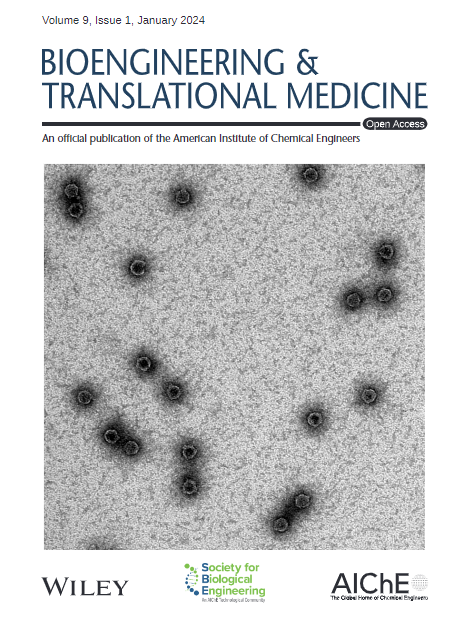3D打印神经引导导管用于无生物制剂的神经再生和血管整合
IF 5.7
2区 医学
Q1 ENGINEERING, BIOMEDICAL
引用次数: 0
摘要
临床需要一种有效的神经引导导管来治疗周围神经损伤。许多研究探索了不同的材料和主动线索来指导神经再生,并取得了一些成功。然而,没有一种表现出与临床标准自体移植物相当或更好的功能恢复。自体移植物通常不足以重建长神经损伤,如坐骨神经或臂丛神经。人工神经引导导管(NGCs)已被研究用于指导这些损伤的轴突再生和功能恢复。我们设计了一种不含生物制剂的基于水凝胶的多通道导管,具有明确的微尺度特征,以引导轴突的生长。为了研究神经外血管浸润及其对功能恢复的影响,我们还设计了一个与轴突引导通道正交的多微通道导管。使用我们定制的快速投影、图像引导、动态(Rapid)生物打印系统,我们能够在几分钟内从一个毫升体积的预聚体大桶中制造出每个水凝胶导管。凭借我们最先进的打印平台,我们已经实现了通道壁宽为10 μm的NGCs。我们将NGCs植入小鼠坐骨神经横断损伤模型17周。我们通过动态步态分析和复合肌肉动作电位(CMAP)电生理分析来评估整个恢复期间的功能恢复。无孔和微孔导管组的神经功能再生与自体移植物组相当。此外,两组导管均可使大容量运动功能恢复到损伤前的水平。本文章由计算机程序翻译,如有差异,请以英文原文为准。
3D printed nerve guidance conduit for biologics‐free nerve regeneration and vascular integration
There is a clinical need for an effective nerve guidance conduit to treat peripheral nerve injuries. Many studies have explored different materials and active cues to guide neural regeneration, with some success. However, none have demonstrated a comparable or better functional recovery than the clinical standard autograft. Autografts are often insufficient for reconstruction of an injury to long nerves such as the sciatic or brachial plexus. Synthetic nerve guidance conduits (NGCs) have been investigated for these injuries to guide axonal regeneration and lead to functional recovery. We have designed a biologics‐free hydrogel‐based multi‐channel conduit with defined microscale features to guide axonal outgrowth. To investigate extraneural vascular infiltration and its effects on functional recovery, we also designed a multi‐microchannel conduit with defined regularly spaced micropores, orthogonal to the axon guidance channels. Using our custom‐built Rapid Projection, Image‐guided, Dynamic (RaPID) bioprinting system, we were able to fabricate each hydrogel conduit within minutes from a milliliter‐volume prepolymer vat. With our state‐of‐the‐art printing platform, we have achieved NGCs with a consistent channel wall width of 10 μm. We implanted the NGCs for 17 weeks in a murine sciatic nerve transection injury model. We assessed the functional recovery by dynamic gait analysis throughout the recovery period and by compound muscle action potential (CMAP) electrophysiology before NGC harvesting. Both the non‐porous and micro‐porous conduit groups led to functional nerve regeneration on par with the autograft group. Further, both conduit groups resulted in restoration of bulk motor function to pre‐injury performance.
求助全文
通过发布文献求助,成功后即可免费获取论文全文。
去求助
来源期刊

Bioengineering & Translational Medicine
Pharmacology, Toxicology and Pharmaceutics-Pharmaceutical Science
CiteScore
8.40
自引率
4.10%
发文量
150
审稿时长
12 weeks
期刊介绍:
Bioengineering & Translational Medicine, an official, peer-reviewed online open-access journal of the American Institute of Chemical Engineers (AIChE) and the Society for Biological Engineering (SBE), focuses on how chemical and biological engineering approaches drive innovative technologies and solutions that impact clinical practice and commercial healthcare products.
 求助内容:
求助内容: 应助结果提醒方式:
应助结果提醒方式:


